~ A Chippewa Canoe Chronicle ~
“This canoe was first seen by the previous owner hanging in a store in northern Wisconsin. He was told it was displayed there since 1911. For years he attempted to acquire it from the store owner who finally agreed to sell it to him. He took it back to his home in Jacksonvile, Illinois where he had an automobile dealership.”
“One day he decided to sell it and having read about a man very interested in canoes and their history in an article in the Chicago Tribune, he contacted me at the Chicagoland Canoe Base and offered it for sale. A deal was made and when I had an opportunity to travel to southern Illinois, I stopped by to pick up the old canoe.” Ralph Frese, August 23, 2012
Video Link<><> 85-year-old restores birch bark canoe | abc7chicago.com <><>
“A very unique and historic American Indian Artifact belongs to Ralph Frese and the Chicago Maritime Society. As a member of Rogers Street Fishing Village, a 501c3 not for profit corporation, Robert Cornwell has arranged the permanent loan of this artifact to be on permanent loan to Rogers Street from CMS. Ralph has set two stipulations. The first is that it is to be restored to museum display quality. The second is that the restorer is Ferdy Goode of Arbor Vitae, Wisconsin. The benefits of restoring such a rare artifact helps the modern American to see past cultures of our lands and how they traveled, hunted, fished, traded, and lived.” Robert Cornwell, August 13, 2012
“The Indian canoe must be as close to engineering perfection as most inventions are likely to come. Built by the Original People (Anishinaabe) of this land over a century ago, this early canoe is a very valuable historical treasure. The four main materials used to create this canoe are birch bark, white cedar, roots of spruce or jack-pine, and pine and spruce pitch to seal the seams. There are very few of these artifacts existing today which makes them quite special when properly preserved for the future. I look forward to working on this project.” Ferdy Goode, August 11, 2012
“The canoe’s return to the Northwoods has a spiritual dimension….it has not heard the language of the Anishinaabe builders and paddlers for a long time. It still needs this connection to become complete.”
<><> Canoe Assessment <><>
Video Link <-><> Chippewa Bark Canoe Intro – YouTube <><->

CONDITION….Bark broken out and curling, reinforcing bark missing or damaged, root lashings rotten and broken, ribs out-of-place, thwarts missing

Detail of canoe’s damage….rib tips exposed…the main sheet of bark has seperated from the gunwale assembly (notice the bark tabs over the end of the rib tip)

Man-board (aniniiwaatig) showing powder-pigment design of a bullhead…this is the canoe makers personal mark signifying that he is a member of the Owaazisii {Bullhead Clan}…
According to Ojibwe tradition, the way the Ojibwe people organized themselves into grand families, called dodem or clans, is very important. In the History of the Ojibwe Nation, William Warren explains the beginning of the Ojibwe clan system. According to Ojibwe tradition, there were originally six human beings that came out of the sea to live among Ojibwe. These six beings, which were Wawaazisii (Bullhead), Ajejauk (Crane), Makwa (Bear), Moosance (Little Moose), Waabizheshi (Marten), and Bineshii (Thunderbird), created the original clans. One of the original beings, the Thunderbird, always covered his eyes, because when he looked at the Anishinabeg, they died. The other five beings urged Thunderbird to return to the sea because his powers were so strong. That is why the Anishinabeg do not have a Thunderbird clan today.
six human beings that came out of the sea to live among Ojibwe. These six beings, which were Wawaazisii (Bullhead), Ajejauk (Crane), Makwa (Bear), Moosance (Little Moose), Waabizheshi (Marten), and Bineshii (Thunderbird), created the original clans. One of the original beings, the Thunderbird, always covered his eyes, because when he looked at the Anishinabeg, they died. The other five beings urged Thunderbird to return to the sea because his powers were so strong. That is why the Anishinabeg do not have a Thunderbird clan today.
<.><> Canoe Origin <><.>
Correspondence with Earl Otchingwanigan, Ojibwe elder and birchbark canoe maker
Greetings Ferdy, We’ve been on the “go” of late but returning home from Lac Courte Oreilles just last night found your email awaiting….thus, I’ll write a few rows in reply….first, it appears you have an interesting project in hand….secondly, after looking at your video and still-photos posted regarding the canoe you have questions about, indeedy, the canoe speaks of itself in a number of different ways which I have familarity of…. my first comment is, judging by your pictures, it is safe to say that the canoe was most likely built no earlier than 1895 but no later than 1910 because of the fact “wire nails” as noted on the wales did not exist before 1890 and certainly, after their debut, distribution and eventual popularity would take several years to appear in the hinterlands….when I say no later than 1910, there are several clues that point to that era including that of its maker and possible area it came from….
However, before saying further, is there any history as to how it ended up in the Chicago area?….Cheers, Earl O.
I appreciate you sending the attachment from Ralph Frese regarding how the canoe ended up in Chicago….
Although, it gives little info regarding the orgin of the canoe other than being from northern Wisconsin, because when considered, it is a rather vast area….but, it was interesting that the year the canoe was purchased from the store owner, was 1911, which verifies my first comment that the canoe was built between 1895 and 1910, right on the mark so to speak if I may say….
Comment #2: it is my strong opinion that the canoe is of Ojibwe origin which has amongest other clues, one striking clue which is the maker’s mark on one of the two manboards which indicates that he was of the Owaazisii [Bullhead] Clan….the Owaazisii Clan is one of the most important clans of the Ojibwe, because it is one of the original clans which numbered 5 in the “beginning”….an interesting sidenote perhaps, the Owaazisii clan people were considered master canoe builders….you’ll will note that on the doodem [totem] image of the bullhead fish on the manboard, is that, on the left side of the fish, each of the two fins has 6 lines, on the right side, there are 5 lines on each of the two fins….
Comment #3: you referred to the word “style” recently, but if I may use the word “workmanship” in looking at the canoe, at least from a photo distance, there are some characteristics of the “Ojibwe Canoe Project” canoe you have in hand that speak of a “triangular geographical area” from the headwaters of the Wisconsin River [Lac Vieux Desert], including the Boulder Junction area and then running east along the Brule River to Chicaugon Lake [Gaa-namegosikaag Ojibwe village], and further along the Brule to where the Brule and Paint River meet and to form the head of the Menominee River where the most northern Indian village of the Menominee once existed at a place called Maji-nibiikaang [Bad Water], and thence, southerly into Wisconsin to places called Pickerel Lake and Mole Lake, but at the extreme, even include the most eastern part of the “triangular geographical area” could possibly include as far east as Bawiting or also known as Bawitigong [Sault Ste Marie]….
The clues that suggest that triangular area include the shape of the man board; that is, the project canoe you are working on has a “rounded head” rather than the squared-off….this is a typical and distinct feature of birch barks from the triangular area I have speaks of….several birch barks that were made at Chicaugon Lake and Lac Vieux Desert that were presented to Herbert Larson [early 1900 Iron County, MI, County Road Commission engineer], have rounded man board heads which had elaborately painted designs on them….the Iron County [MI] Museum has a birch bark made at Chicaugon Lake that has a “rounded painted man board head,” in fact, the canoe as a whole, seems to have some similiar features to your “Ojibwe Canoe Project” canoe….also, you may recall the rather large canoe [which was made at the Sault in the 1880’s], on exhibit next to the wigwam display Christie and I built for the Marquette Regional History Museum, has rounded man board heads….
Comment #4: The painted designs that are on your “Ojibwe Canoe Project” canoe have familiarity with me….the birch barks from this area were noted for painted designs on man boards and even on the fore most where the high-ended ends begin, some even had painted wales….interesting enough, I yet have one of my Uncle Gus [Duffly] traditional Ojibwe fish “poles” which I know he had made back in the 1920’s has a painted design on it that has exact, at least partically, same design feature on your “Ojibwe Canoe Project” canoe man board….if you might not be familiar with a traditional Ojibwe fish “pole,” it is not really a pole but a carved fishing device that resembles paddle-like and was commonly used in ice fishing but also could be used to fish with from a canoe, of course this one of many fishing techniques the Ojibwe had including spearing, netting, and funnel traps….
So, to kinda sum up what I’m saying, is that, there is this “geographic triangle area” if you will, notablely with the Brule River area that seperates Northern Wisconsin and the Upper Pennisula of Michigan as its centerpiece that is known for the “rounded and painted head man board” feature….but that is not to say, that all birch barks from this particular area had a “rounded head man board,’ but it seems to be kinda like a “trade mark”….for your info, another feature of the man board in this triangle geographical area, was the top of the man board rather than being round, or squared-off, had a top edge that resembled the letter “W” if you can envisioned that feature….a good example of that is the model birch bark that was on summer exhibit in the room adjacent to the atrium in the MRHM; this bark was made by Waabishkiniked who lived at Chicaugon Lake, and then at Bad Water….the Bad Water Indian village was predominately Ominoominiig [Menominee Indian], but a number of Ojibwe also resided there because of the proxmity to and relationship with the Chicaugon Lake Ojibwe….Waabishkiniked was well known in this area and in later years lived at Randville, Michigan….he and his wife Josephine used to cavort with some of my relatives back in the day…
To conjecture where the location the canoe was exactly made at is difficult to say….if Ralph Frese has or could include info where the store that the canoe in 1911 was at, of course that would be extremely helpful….but considering some of the clues as outlined in the 4 comments, me thinks it could be suggested, or at least there is hinting, that the canoe originated in this “geographic triangle”….especially, the area of Wiisaakode-ziibi [Brule River to the headwaters of the Wisconsin River], but too, I wouldn’t want to rule out the possiblity of Flambeau….which comes to mind that back in the day, the Lac Vieux Desert Indian village people used to sell pretty much all their craftwork to a store in Land O’ Lakes Wisconsin…… Cheers, Earl

Detail of canoe’s interior after removing the sheathing and ribs….two long cracks or breaks in the bottom bark that go from gunwale to gunwale….scratch lines are also visible….these lines indicate the size of the building frame that was originally used to shape the bottom of the canoe.
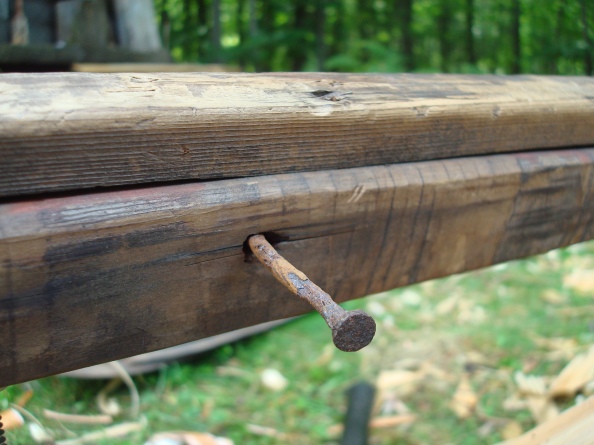
Large steel nails were used by the builder to secure the gunwales and cap prior to lashing them with split root.
<><> Repair and Restoration <><>

The gunwale cap nails have been removed…the cedar inwale & outwale have been separated to work the bark shell up and in-between them

The large cracks in the middle bottom and side-bark have been reinforced and strengthened by adding new birch bark to those areas….a temporary thwart has been carved to help stabilize the spread of the gunwale assembly
Link to video <-><> Gore Sewing on Vimeo <-><>
Video Link- <-><> Root Splitting on Vimeo <><->

Carving a replacement thwart (cross-piece) from split white cedar using the traditional wagikomaan {crooked knife}{canoe-knife}
Video Link- <-><> Thwart Carving on Vimeo <><->

Rib tip detail showing the result of tremendous rib-presure being exerted over the years against the chamfer between the gunwale assembly.

While re-sheathing the canoe with the original pieces, thin temporary ribs of ash hold the sheathing in place until the ribs are reinstalled. Notice the newly carved thwarts have been fit into place

The root is all prepared so now begins the laborious process of sewing all the gunwale lashings numbering 80 in total.

Making one of the many gunwale lashings necessary to continue the restoration and conservation of this fine old craft. Some of the ribs have also been reinstalled tensioning the bark once again.
- Gunwale lashing of spruce root
Video Link <><> Gunwale Lashing on Vimeo <><>

Using a custom made rib tapper and driving stick to set the ribs in their final vertical position; being very cautious not to exert to much pressure on the old bark hull

One of the original bark tabs placed over the rib tip to lengthen the rib during the final tuning of the ribs
Video Link <-><-> Rib Tapping and Reinstalling on Vimeo <-><->
Video Link <>.<> Saw-Tooth Stitch on Vimeo <>.<>
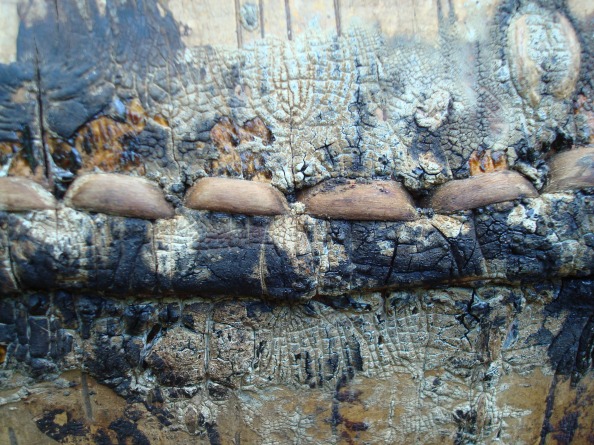
The original pitch on this lateral seam may be a hundred years old; the roots are still in good condition

Traditional pine pitch is applied hot off the fire using a carved wooden spatula. This is the last step in the conservation and restoration of this birch bark canoe.
Video Link <>—> Pitching on Vimeo

A notch on the forward side of the end thwart indicates that there was a waswagon {jack-light/flaming birch bark torch} inserted at this end of the canoe at one time for the purpose of night spearing of fish.

FISHING BY TORCHLIGHT, An oil painting by Paul Kane, 1810-1871, depicting fishing at night by torchlight and canoe.
“Back in the day, most any Ojibwe would not have even considered repairing a canoe in this condition save for removing salvageable wooden parts such as thwarts, stem pieces and ribs. It was easier and more practical to begin anew not to mention the safety factor.”
<->
“However, today such relic canoes similar to this one, are well worth the attempt to restore for the simple fact there are so few in existence. They are important reminders of an era long past and essential to truly understand a large span of American history.”
<->
“The canoe has been given a new life thanks to a few concerned people that appreciate this delicate water craft. It is hope that it will live another 100 years perhaps longer if given the opportunity it rightly deserves. Ferdy Goode did a proper restoration and to be assured, the original builder of this unique canoe would approve as well as the birch bark canoe-maker writing this narrative.” Miigwech Ferdy….. Earl Otchingwanigan,canoe maker, October 12, 2012
<->
“The canoe’s journey is now complete. With a traditional ceremony performed by Earl, it has been revived and is now alive once again, at home in the Northwoods.” Ferdy Goode, October 12, 2012
Video Link >>> Earl Otchingwanigan Speaks on Vimeo
Beaver Bark Canoes Productions <><> copyright 2012




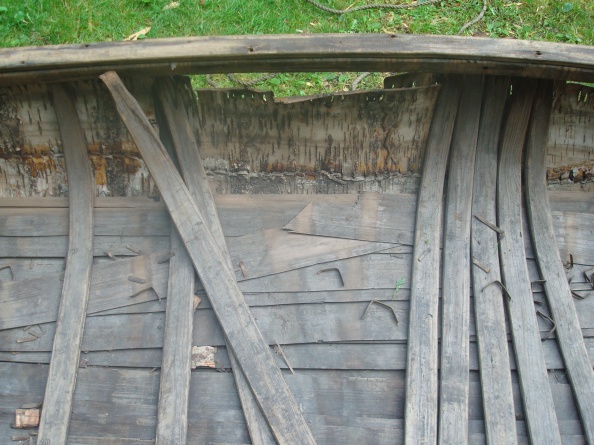


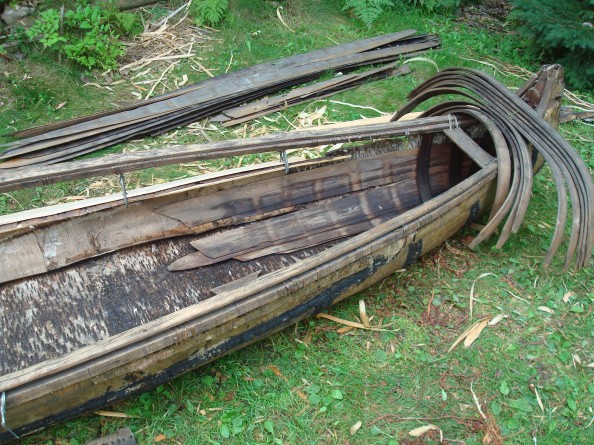







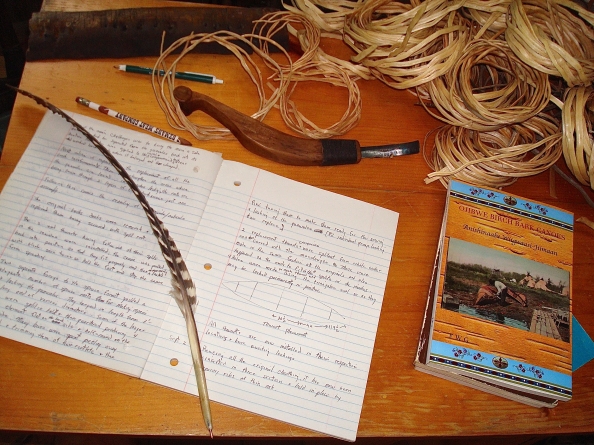






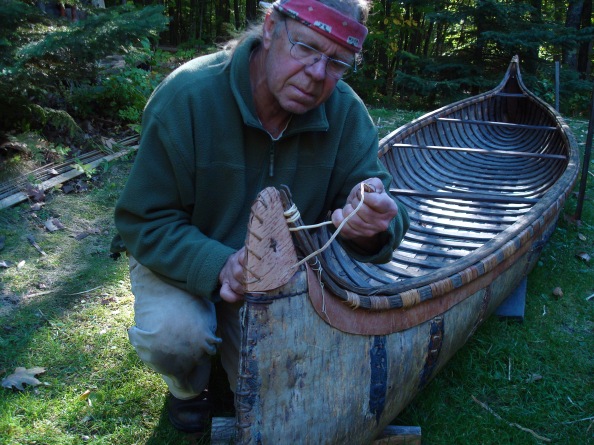
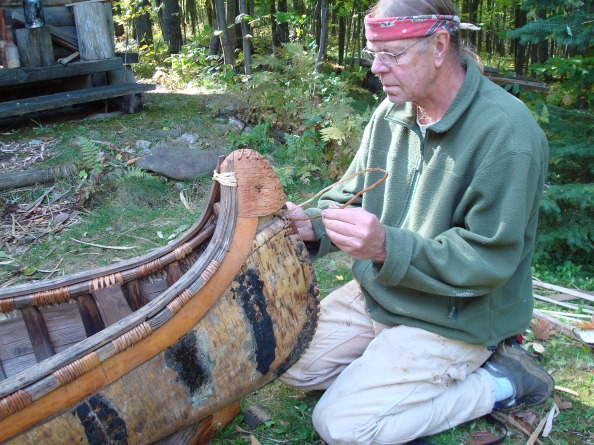










beaverbarkcanoes
August 14, 2012
I am looking forward to working on this project to restore this fine old canoe
David Wermuth
August 19, 2012
Hi Ferdy, it is obvious to me that stipulation number two makes stipulation number one moot. This is fascinating. Am I right in guessing there were no tabs?
beaverbarkcanoes
August 19, 2012
Too much stipulating is obvious…..No tabs Dave
Bob Cornwell
August 20, 2012
Thanks Ferdy! I love this. The camera is doing a great jog as well. Feel free to post some vids of cool steps, esp when you get to carving, stitching
Jody Henseler
August 25, 2012
This is awesome! We live in Two Rivers and are very excited to see that this amazing canoe will be housed right here and being restored by Ferdy!
Rob Henseler
August 25, 2012
How Wonderful!
As a resident of Two Rivers, an admirer of Ferdy’s work, and a lover of old canoes, I’m excited to watch this project progress and look forward to seeing the canoe at Rogers St.
beaverbarkcanoes
August 25, 2012
Yesterday I was making a repair by replacing the bark decks on each end. “It’s a slow process to bring this fine old canoe back to life.”
the bradguy
September 28, 2012
Unbelievable what you’ve done with this old canoe…
Enrico Garp
October 1, 2014
This is a great work!!! Wow!!! Chapeau!!!
Donald Matthews
June 28, 2017
Beautiful restoration. Thanks to Ralph Frese and friends, I’ve admired the birchbarks since 1972.
surfsensei
October 28, 2020
Excellent work and good to see it done with such acknowledgement and respect to the tradition and culture. That is really impressive.
Paul H. Davenport
May 6, 2021
I must thank you for your immense knowledge, skill, patience, energy and love in the restoration of this First People’s canoe.
It is a representation of those who came before and their spirits that still echo if…
you listen.
May the Creator guide you on your journey’s quest.
With reverence,
Smiling Fox
May